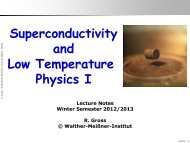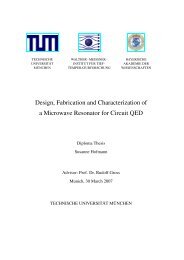Applied Superconductivity - Walther Meißner Institut - Bayerische ...
Applied Superconductivity - Walther Meißner Institut - Bayerische ...
Applied Superconductivity - Walther Meißner Institut - Bayerische ...
- No tags were found...
Create successful ePaper yourself
Turn your PDF publications into a flip-book with our unique Google optimized e-Paper software.
174 R. GROSS AND A. MARX Chapter 4I I ID D DW W WFigure 4.9: Sketch of various geometries for planar dc-SQUIDs with washer geometry.has the inductanceL ≃ 1.25 µ 0 D (4.1.52)in the limit W ≫ D. That is, the loop inductance scales with the inner diameter D. In contrast, theeffective area of the SQUID loop is 31A eff ∝ D ·W , (4.1.53)that is, it scales with the outer dimension of the washer. Of course, one cannot increase W arbitrarily,since for large W one starts to trap magnetic flux quanta in the washer area during cool down even insmall magnetic fields. The thermally activated motion of these flux quanta generate disturbing 1/ f -noise.An experimental example for the flux focusing effect is shown in Fig. 4.10 for a geometry shown in theinset. Here, A eff /D 2 is plotted versus W 2 /D 2 on a double logarithmic scale. In such plot a straight linewith slope 1/2 is expected according to (4.1.53) in good agreement with the data.We briefly address the inductance and the coupling of a spiral input coil that can be put on top of thewasher as shown in Fig. 4.11. Neglecting the parasitic inductance associated with the Josephson junctions,the following expressions for the inductance L i of the spiral input coil, the mutual inductance M iand the coupling coefficient α 2 between the spiral and the SQUID loop are found:L i ≃ n 2 L + L s (4.1.54)M i ≃ √ n 2 L · L = nL (4.1.55)α 2 ≃11 + L s /n 2 L . (4.1.56)Here, L s is the stripline inductance of the spiral coil, n the number of turns of the spiral input coil andn 2 L the geometric self-inductance of the input coil. For the estimate of M i we have assumed that the fluxdue to a current flowing in the spiral input coil is perfectly coupled in the SQUID hole. The couplingcoefficient α is obtained from the expression α = M i / √ L i L = nL/ √ (n 2 L + L s )L. As an example, forD = 20 µm we obtain L ≃ 30 pH. For a 50 turn input coil we obtain L i ≃ 75 nH 32 and M i ≃ 1.5 nH. The31 M.B. Ketchen, W.J. Gallagher, A.W. Kleinsasser, S. Murphy, J.R. Clem, in SQUID’85, H.D. Hahlbohm and H. Lübbigeds., <strong>Walther</strong> de Gruyter, Berlin (1985), p. 865.32 The stripline inductance is usually negligible for a 50 turn coil.© <strong>Walther</strong>-Meißner-<strong>Institut</strong>
















